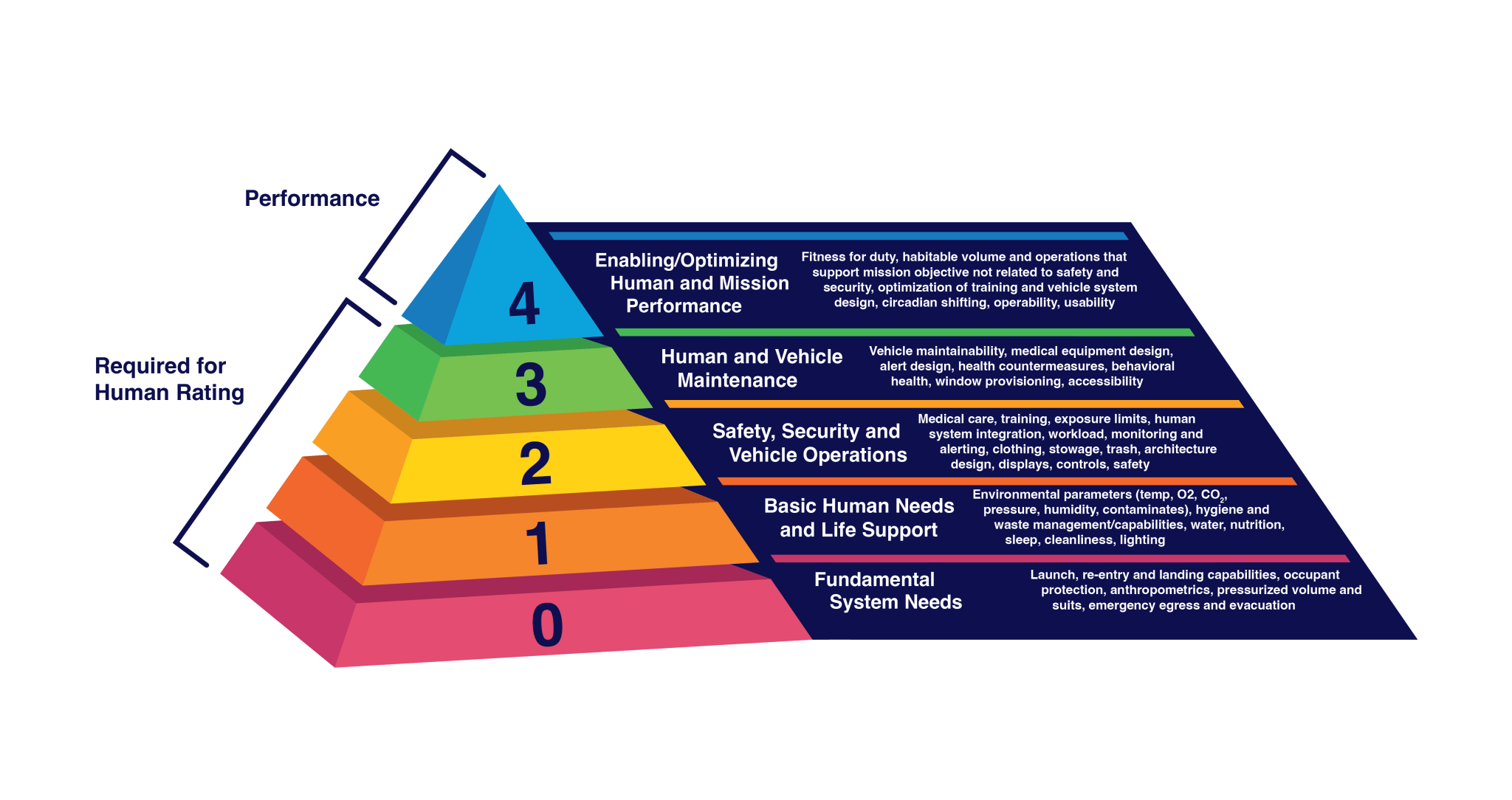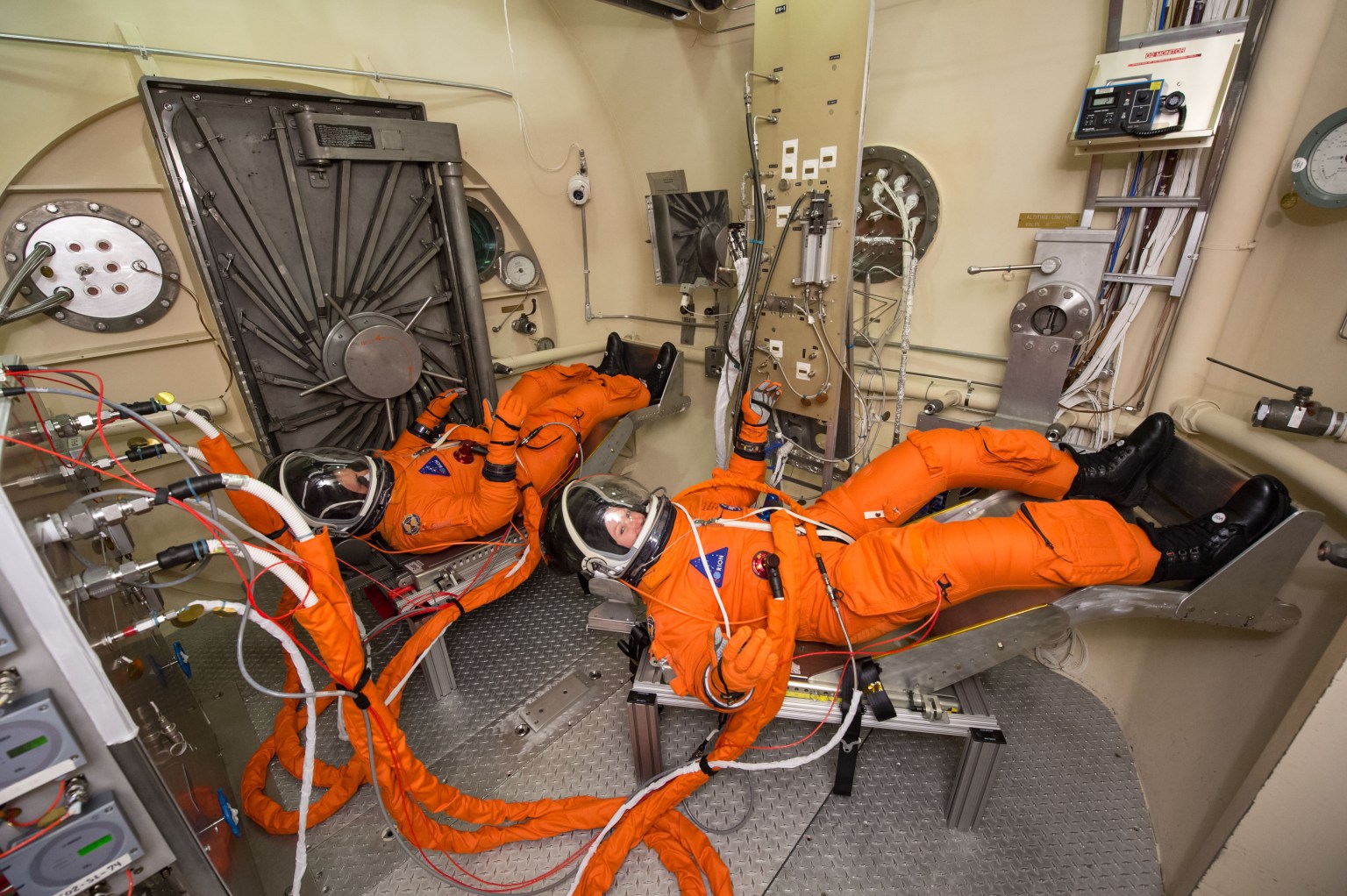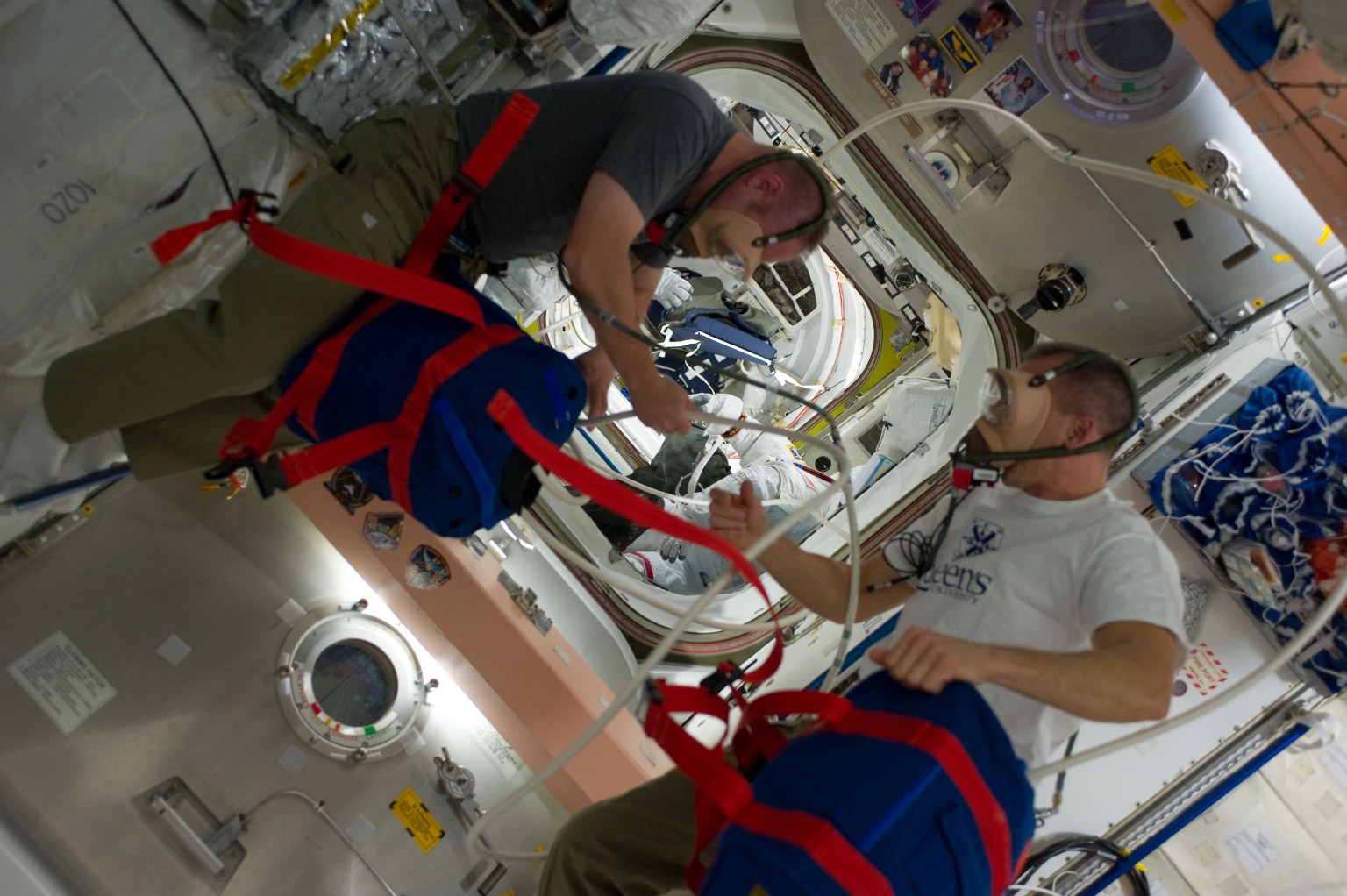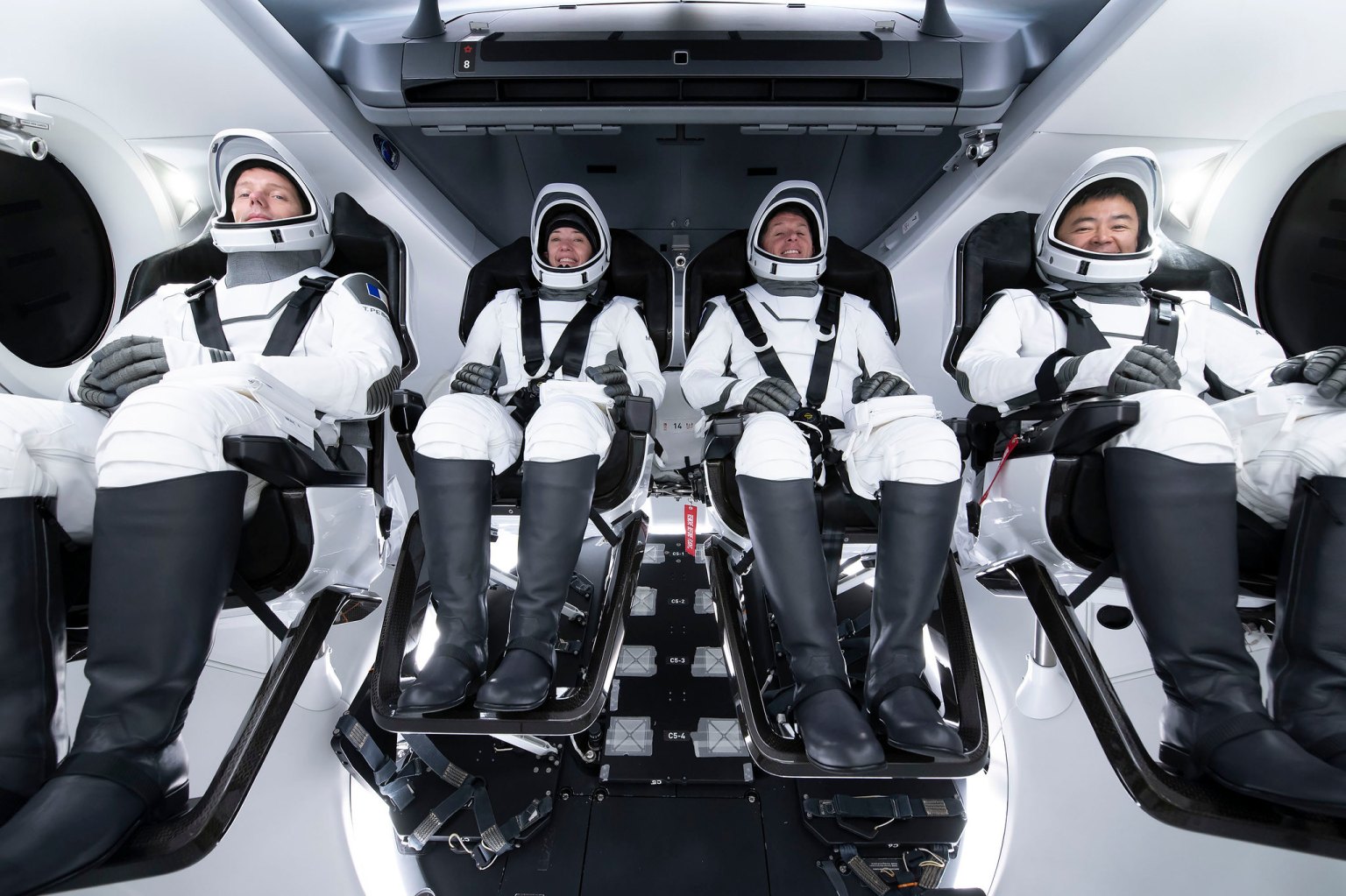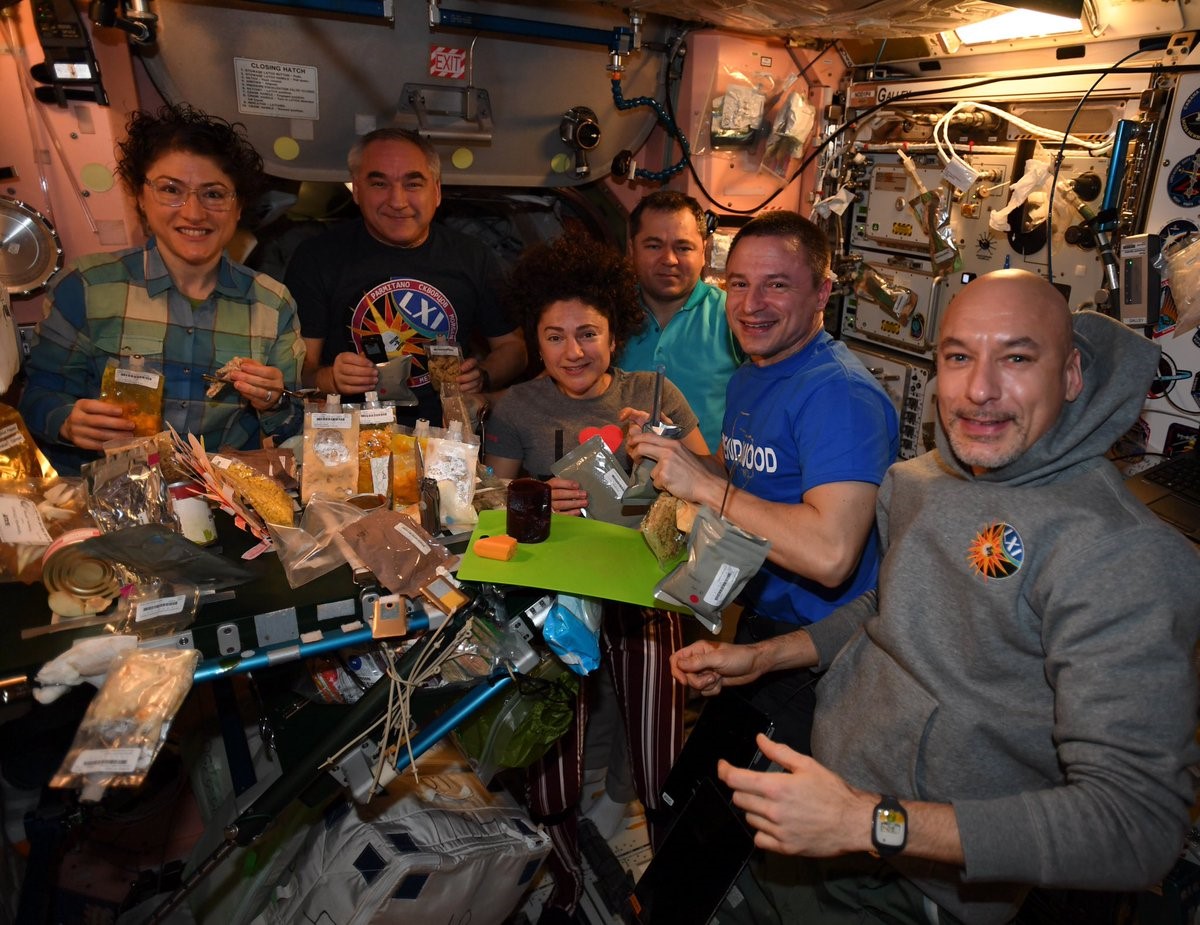Applying Human Rating to the
NASA-STD-3001: An Overview
NASA-STD-3001, NASA Spaceflight Human-System Standard Volume 1 and 2, establishes Agency-level technical requirements that enable human spaceflight missions by minimizing health risks, providing vehicle design parameters, and optimizing performance of flight and ground crew. Applicability and tailoring of these requirements are determined based on each program’s mission profile and procurement strategy.
While NASA-STD-3001 provides the most comprehensive resource for these agency level requirements, a core subset is applicable to human rating. Requirements categorized as “Human Rated” follow three key human-rated space system principles:
- System level safety features;
- Accommodation of human interaction with system; and
- Safe recovery.
NASA-STD-3001 Pyramid Hierarchy
A “Standards pyramid of hierarchy” was developed to aid in the determination of individual standard’s impact on missions—particularly useful during the formulation stage of new programs. This tool provides a look “across” all current NASA-STD-3001 requirements in a condensed, hierarchical format useful for assessing impact on a mission’s success related to loss of crew, mission, and/or individual mission objectives. The pyramid also categorizes the technical requirements that increase the probability of achieving mission objectives.
To provide clarify on requirements categorized as ‘Human Rated,’ the Standards Pyramid was categorized into two groups: human-rated and those classified as primarily enabling and optimizing performance. While all NASA-STD-3001 requirements are considered valuable to human spaceflight, a subset of Human-Rating requirements was developed to serve as a guidepost for need-to-have factors critical for maintaining human safety (e.g. foundational vehicle structure; environmental conditions; safe egress).
What is a Human-Rated Space System?
A human-rated system accommodates human needs, effectively utilizes human capabilities, controls hazards with sufficient certainty to be considered safe for human operations, and provides the capability to safely recover from emergency situations. The concept of human-rating a space system entails three fundamental tenets:
1. Human-rating is the process of evaluating and assuring that the total system can safely conduct the required human missions.
2. Human-rating includes the incorporation of design features and capabilities that accommodate human interaction with the system to enhance overall safety and mission success.
3. Human-rating includes the incorporation of design features and capabilities to enable safe recovery of the crew from hazardous situations.
Full compliance for human rating occurs when all levied requirements or considerations at each level have been appropriately addressed.
Hierarchy Descriptions
- 0 Fundamental System Needs – Meeting the requirements needed to enable a vehicle or suit that provides the minimum structural needs for a crewmember to be contained within or to have an emergency egress.
- 1 Basic Human Needs and Life Support – The minimum requirements for a human to survive.
- 2 Safety, Security & Vehicle Operations – Vehicle design and operations that ensures the safety of the crew (pre-, in- and post-mission).
- 3 Human & Vehicle Maintenance – Vehicle and crew maintainability needs, either through equipment design or capabilities that enable continued support of the crew and vehicle health.
- 4 Enabling and Optimizing Human and Mission Performance – Additional requirements that would optimize the mission by enabling the success of mission objectives and the crew health or performance.
“The concept of a man-rated space system entails the incorporation of those design features and requirements necessary to accommodate human participants within the system and thus provide the capability to safely conduct manned operations, including safe recovery from any credible emergency situation. Man-rating is the process of evaluating and assuring that the total system, both hardware and software, has the ability to meet prescribed, safety oriented design and operational criteria and requirements, and becomes involved in all program activities including design and development, test and verification, management and control and finally, certification for operational readiness”
“A Review of Man-Rating in Past and Current Manned Space Flight Programs”, A. Bond, 1988
Related Documents
- NASA-STD-3001 Volume 1 Requirement Compliance Matrix with Human Rating
- NASA-STD-3001 Volume 2 Requirement Compliance Matrix with Human Rating
- HEOMD-003 Crewed Deep Space Systems Human Rating Certification Requirements and Standards for NASA Missions (2021)
- NASA-SP-6104 A Perspective on the Human Rating Process of Spacecraft Both Past and Present (1995)
- NASA-STD-8719.29 NASA Technical Requirements for Human-Rating (2023)
- NASA’s Human Rating Requirements – A Historical Interpretive Perspective (2011)
- NPR 8705.2C Human-Rating Requirements for Space Systems (2017)
- Spacecraft Human-Rating: Historical Overview and Implementation Considerations (2014)
0. Fundamental System Needs
(Required for human rating)
| V1 3007 Medical Evacuation | V2 6009 Decompression Sickness Treatment Capability | V2 6112 Hang Time Limit | V2 11032 LEA Suited Decompression Sickness Prevention Capability |
| V1 3008 In-Mission Evacuation to Definitive Medical Care Facilities | V2 6064 Sustained Translational Acceleration Limits | V2 6113 Crew Limits in Launch Orientation | V2 12004 Anthropometry, Biomechanics, Range of Motion, and Strength |
| V2 4102 Functional Anthropometric Accommodation | V2 6065 Rotational Velocity | V2 6154 Extraterrestrial Surface Transport Vehicle Sustained Translation Acceleration Limits | V2 12043 Emergency Egress at the Launch Site |
| V2 4103 Body Mass, Volume, and Surface Area Data | V2 6066 Sustained Rotational Acceleration Due to Cross-Coupled Rotation | V2 6155 Extraterrestrial Surface Transport Vehicle Translation Jerk Limits | V2 12044 Emergency Egress to Medical Care |
| V2 4104 Crew Operational Loads | V2 6067 Transient Rotational Acceleration | V2 6156 Blunt Trauma Limits for Enabling Performance | V2 12045 Nominal Timely Egress |
| V2 4105 Withstand Crew Loads | V2 6069 Acceleration Injury Prevention | V2 6090 Vibration Exposures during Dynamic Phases of Flight | V2 12046 Emergency Egress Acceleration Limits |
| V2 4013 Muscle Effects | V2 6070 Injury Risk Criterion | V2 11100 Pressure Suits for Protection from Cabin Depressurization | |
- NASA-STD-3001 Volume 1: Crew Health (full text)
- NASA-STD-3001 Volume 2: Human Factors, Habitability, and Environmental Health (full text)
1. Basic Human Needs
(Required for human rating)
| V2 6002 Inert Diluent Gas | V2 6047 Toxic Hazard Level Three | V2 6095 Ionizing Radiation Protection Limit | V2 7027 Body Waste Trash Receptacle Accessibility |
| V2 6003 O2 Partial Pressure Range for Crew Exposure | V2 6048 Toxic Hazard Level Four | V2 7001 Food Quality | V2 7029 Body Waste Management Maintenance |
| V2 6004 Nominal Vehicle/Habitat Carbon Dioxide Levels | V2 6049 Chemical Decomposition | V2 7003 Food Caloric Content | V2 7070 Sleep Accommodation |
| V2 6006 Total Pressure Tolerance Range for Indefinite Crew Exposure | V2 6075 Ceiling Limit for Launch Abort | V2 7004 EVA Food Caloric Content | V2 7073 Partial-g Sleeping |
| V2 6007 Rate of Pressure Change | V2 6076 Launch, Entry, and Abort Impulse Noise Limits | V2 7100 Food Nutrient Composition | V2 11011 Suited Crewmember Heat Storage |
| V2 6150 Barotrauma Prevention | V2 6077 Hazardous Noise Limits for All Phases Except Launch, Entry, and Abort | V2 7110 Food and Impacts to Environmental Systems | V2 11013 Suited Body Waste Management – Provision |
| V2 6012 Crew Health Environmental Limits | V2 6115 24-Hour Noise Exposure Limits | V2 7014 Food Spill Control | V2 11028 EVA Suit Urine Collection |
| V2 6050 Atmosphere Contamination Limit | V2 6078 Continuous Noise Limits | V2 7008 Food Preparation | V2 11014 LEA Suit Urine Collection |
| V2 6052 Particulate Matter | V2 6079 Crew Sleep Continuous Noise Limits | V2 7016 Personal Hygiene Capability | V2 11015 Suit Urine Collection per Day – Contingency |
| V2 6053 Lunar Dust Contamination | V2 6080 Intermittent Noise Limits | V2 7017 Body Cleansing Privacy | V2 11016 Suit Feces Collection per Day – Contingency |
| V2 6059 Microbial Air Contamination | V2 6082 Annoyance Noise Limits for Crew Sleep | V2 7020 Body Waste Management Capability | V2 11025 Suited Nutrition |
| V2 6026 Potable Water Quality | V2 6083 Impulse Noise Limit | V2 7021 Body Waste Management System Location | V2 11029 LEA Suited Hydration |
| V2 6051 Water Contamination Control | V2 6085 Infrasonic Sound Pressure Limits | V2 7023 Body Waste Management Provision | V2 11030 EVA Suited Hydration |
| V2 6109 Water Quantity | V2 6092 Vibration Exposure Limits during Sleep | V2 7024 Body Waste Accommodation | V2 11033 Suited Thermal Control |
| V2 6110 Water Temperature | V2 6098 Radiation Environments | V2 7025 Body Waste Containment | V2 11039 Nominal Spacesuit Carbon Dioxide Levels |
- NASA-STD-3001 Volume 1: Crew Health (full text)
- NASA-STD-3001 Volume 2: Human Factors, Habitability, and Environmental Health (full text)
2. Safety, Security, and Vehicle Operations
(Required for human rating)
| V1 3000 Medical Management | V2 6108 Off-Nominal Vehicle/Habitat Atmospheric Ventilation | V2 8006 Interference | V2 9054 Protective Equipment Use |
| V1 3002 Pre-Mission Preventive Health Care | V2 6046 Water Quality Monitoring and Alerting | V2 8007 Spatial and Interface Orientation | V2 9055 Equipment Automation of Rescue Aids |
| V1 3003 In-Mission Preventive Health Care | V2 6060 Biological Payloads | V2 8013 Intravehicular Translation Paths | V2 9056 Use of Hearing Protection |
| V1 3004 In-Mission Medical Care | V2 6061 Environment Cross-Contamination | V2 8014 Emergency Escape Paths | V2 9057 Hearing Protection Provision |
| V1 3009 Palliative Comfort Care | V2 6062 Availability of Environmental Hazards Information | V2 8020 Assisted Ingress and Egress Translation Path | V2 9058 Hearing Protection Interference |
| V1 3010 Termination of Care | V2 6063 Contamination Cleanup | V2 11005 EVA Translation Path Hazard Avoidance | V2 9059 Fire Detecting, Warning, and Extinguishing |
| V1 3050 Pre-Mission Crew Mortality Plan | V2 6111 Dynamic Mission Phases Monitoring and Analysis | V2 8022 Hatches and Door Operation without Tools | V2 10152 System Latency for Piloting |
| V1 3051 Pronouncement of Crew Death | V2 6073 Launch, Entry, and Abort Noise Exposure Limits | V2 8023 Unlatching Hatches | V2 10080 Command Confirmation |
| V1 3052 In-Mission Forensic Sample Collection | V2 6074 Ceiling Limit for Launch and Entry | V2 8024 Hatch and Door Operating Times | V2 10153 Mode Change Command |
| V1 3053 Crew Mortality Remains Return to Earth | V2 6081 Alarm Maximum Sound Level Limit | V2 8025 Hatch and Door Operating Force | V2 10178 Manual Activation of Emergency Responses |
| V1 3054 In Situ Disposition of Deceased Crewmember Remains | V2 6084 Narrow-Band Noise Limits | V2 8027 Hatchway Size and Shape | V2 10058 Auditory Alert Frequency |
| V1 3055 Surviving Crew Support | V2 6106 Noise Limit for Personal Audio Devices | V2 8028 Pressure Equalization across the Hatch | V2 10056 Alert Sound Level |
| V1 3056 Crew Mortality Mishap Investigation Plan | V2 6087 Acoustic Monitoring | V2 8029 Visibility across the Hatch | V2 10201 Indicator Light Characteristics |
| V1 3012 Terrestrial Launch/Landing Medical Support | V2 6088 Individual Noise Exposure Monitoring | V2 8031 Hatch Closure and Latching Status Indication | V2 10073 Control Operation Supports and Restraints |
| V1 3013 DMCF Medical Care | V2 6091 Long-Duration Vibration Dosage Limits for Health during Non-Sleep Phases of Mission | V2 8032 Hatch Pressure Indication | V2 10158 Moderate-g Control Configuration |
| V1 3014 DMCF Transport | V2 6093 Vibration Limits for Performance | V2 8101 No Drag-Throughs | V2 10159 High-g Control Configuration |
| V1 3015 Certification of Training Plans for Launch/Landing Medical Team | V2 6094 Hand Vibration | V2 8033 Restraints for Crew Tasks | V2 10076 Manual Piloting Control Latency |
| V1 3016 Post-Mission Health Care | V2 6160 Extraterrestrial Surface Transport Vehicle Vibration Limits for Health and Performance | V2 8038 Restraint and Mobility Aid Standardization | V2 10160 Manual Piloting Control Latency Variability |
| V1 3017 Post-Mission Reconditioning | V2 6161 Intravehicular Area Monitoring of Space Radiation Exposure | V2 8040 Mobility Aid for Assisted Ingress and Egress | V2 10084 Communication Capability |
| V1 3018 Post-Mission Long-Term Monitoring | V2 6162 Personal Monitoring of Space Radiation Exposure | V2 8041 Unassisted Ingress, Egress, and Escape Mobility Aids | V2 10161 Automation System Status Provision |
| V1 4029 As Low as Reasonably Achievable (ALARA) Principle | V2 6163 Area Monitoring of Radiation Exposure from Nuclear Technologies | V2 8042 Mobility Aid Provision | V2 10165 Automation and Robotics Override and Shut-Down Capabilities |
| V1 4030 Career Space Permissible Exposure Limit for Spaceflight Radiation | V2 6164 Alerting of Elevated Exposure Rates | V2 8043 Window Provisioning | V2 10166 Automation System Configuration |
| V1 4031 Radiation Limits – Solar Particle Events | V2 6165 External Space Weather Monitoring | V2 8051 Illumination Levels | V2 10167 Range of Control |
| V1 4032 Crew Radiation Limits for Nuclear Technologies | V2 6102 RF Non-Ionizing Radiation Exposure Limits | V2 8103 Environmental Lighting Attenuation | V2 10168 Automation Failure Recovery |
| V1 4033 Crew Radiation Limits from Galactic Cosmic Radiation | V2 6103 Laser Exposure Limits | V2 8104 Task-Specific Exterior Lighting for Operational Areas Partially or Fully Lit by Sunlight | V2 10170 Decision Aid Clarity |
| V1 5001 Medical Training | V2 6104 Natural Sunlight Exposure Limits | V2 8105 Navigation and Wayfinding (Exterior) | V2 10171 Decision Aid Limitation Notification |
| V1 5002 Crewmember Training | V2 6117 Artificial Light Exposure Limits | V2 8053 Emergency Lighting | V2 10172 Automation Safe Mode |
| V1 5003 Crew Medical Officer Medical Training | V2 7111 Food Safety | V2 8058 Glare Prevention | V2 10173 Safety Default |
| V1 3006 Crew Medical Officers Quantity | V2 7112 Food Production Facility | V2 8106 Extraterrestrial Surface Transport Vehicle (ESTV) Dashboard and Control Lighting | V2 10174 System Initiation |
| V1 5004 Medical Training Verification | V2 7007 Food and Production Area Microorganism Levels | V2 9101 Design for Crew Safety | V2 11125 Suit Materials Compatibility |
| V1 5005 Flight Surgeon Training | V2 7010 Food Contamination Control | V2 9005 Mechanical Hazard | V2 11126 Suit Materials Cleanability |
| V1 5006 Medical Operations Flight Controller Training | V2 7015 Food System Cleaning and Sanitizing | V2 9006 Entrapment | V2 11007 Suit Equilibrium Pressure |
| V1 5007 Support Personnel Training | V2 7101 Body Waste Isolation | V2 9007 Potential Energy | V2 11009 Continuous Noise in Spacesuits |
| V1 5008 Psychological Mission Training | V2 7102 Body Waste Quantities | V2 9008 Protection from Projectiles and Structural Collapse | V2 11010 EVA Suit Radiation Monitoring |
| V1 5009 Physiological Exposure Mission Training | V2 7085 Fecal and Urine Elimination Concurrence | V2 9009 Sharp Corners and Edges – Fixed | V2 11024 Ability to Work in Suits |
| V1 6006 Extravehicular Activities (EVAs) | V2 7035 Urine per Crewmember | V2 9010 Protection from Functionally Sharp Items | V2 11027 Suited Medication Administration |
| V1 6008 Crew Health Operations Concept Document | V2 7043 Medical Capability | V2 9011 Sharp Corners and Edges – Loose | V2 11031 Suited Relative Humidity |
| V1 6009 Medical and Crew Health Technical Requirements Document | V2 7045 Medical Equipment Usability | V2 9012 Burrs | V2 11036 Suited Atmospheric Monitoring and Alerting |
| V2 3006 Human-Centered Task Analysis | V2 7046 Medical Treatment Restraints | V2 9013 Pinch Points | V2 11101 Incapacitated Crew Rescue (ICR) |
| V2 3102 Human Error Analysis | V2 7115 Medical Treatment, Personal Supplies, and Impacts to Environmental Systems | V2 9016 Equipment Handling | V2 12005 Protective Equipment |
| V2 3101 Iterative Developmental Testing | V2 7050 Stowage Provisions | V2 9102 Skin/Tissue Damage Temperature Limits | V2 12006 Volume Accommodation |
| V2 10002 Design-Induced Error | V2 7052 Stowage Location | V2 9103 Pain/Non-Disabling Injury Skin Temperature Limits | V2 12012 Mobility Aids |
| V2 5007 Cognitive Workload | V2 7054 Stowage Restraints | V2 9017 Power Interruption | V2 12013 Equipment Handling Design |
| V2 10200 Physical Workload | V2 7057 Stowage Access while Suited | V2 9018 Energized Status | V2 12014 Inadvertent Operation Prevention |
| V2 5006 Situation Awareness | V2 7058 Identification System | V2 9019 Nominal Physiological Electrical Current Limits | V2 12015 Incorrect Installation Prevention |
| V2 5051 Legibility | V2 7059 Inventory Tracking | V2 9020 Catastrophic Physiological Electrical Current Limits for all Circumstances | V2 12021 Lighting |
| V2 10004 Controllability and Maneuverability During Manual Control (Handling Qualities – Level 1) | V2 7060 Inventory Operations | V2 9021 Catastrophic Physiological Electrical Current Limits for Startle Reaction | V2 12024 Restraints and Platforms |
| V2 5052 Controllability and Maneuverability During Manual Control with Deficiencies (Handling Qualities – Level 2) | V2 7061 Nomenclature Consistency | V2 9022 Body Impedance for Voltage Calculations Utilizing Electrical Current Thresholds | V2 12025 System Feedback |
| V2 5053 Controls for Human Error | V2 7062 Unique Item Identification | V2 9023 Leakage Currents – Medical and Bioinstrumentation Equipment | V2 12026 Stowage Access |
| V2 10027 Protect Against Inadvertent Activation | V2 7063 Interchangeable Item Nomenclature | V2 9024 Fluid/Gas Release | V2 12027 Flight Software Systems |
| V2 10028 Error Detection and Recovery | V2 7064 Trash Accommodation | V2 9025 Fluid/Gas Isolation | V2 12028 Sharp Edge and Burr Injury Prevention |
| V2 6001 Trend Analysis of Environmental and Suit Data | V2 7065 Trash Volume Allocation | V2 9026 Fluid/Gas Containment | V2 12029 Pinch Point Prevention |
| V2 6008 Decompression Sickness (DCS) Risk Identification | V2 7069 Labeling of Hazardous Waste | V2 9028 Isolation of Crew from Spacecraft Equipment | V2 12030 Hazard Controls |
| V2 6014 Crewmember Heat Storage | V2 7074 Clothing Quantity | V2 9031 Connector Actuation without Tools | V2 12031 System Safing for Ground Operations |
| V2 6011 Post Landing Relative Humidity (RH) | V2 7079 Accessibility for Cleaning | V2 9032 Incorrect Mating, Demating Prevention | V2 12032 Contamination Controls |
| V2 7041 Environmental Control During Exercise | V2 7080 Particulate Control | V2 9033 Mating, Demating Hazards | V2 12033 Containment of Fluids and Gases |
| V2 6022 Atmospheric Monitoring and Alerting Parameters | V2 7081 Microbial Surface Contamination | V2 9034 Cable Management | V2 12034 Safe Weight Limit |
| V2 6023 Trace Constituent Monitoring and Alerting | V2 7082 Surface Material Cleaning | V2 9036 Design for Maintenance | V2 12035 Safe Flight System Component Arrangement |
| V2 6024 Combustion Monitoring and Alerting | V2 7083 Cleaning Materials | V2 9037 Commercial Off-the-Shelf (COTS) Equipment Maintenance | V2 12037 Connector Incorrect Mating Prevention |
| V2 6025 Contamination Monitoring and Alerting | V2 6058 Condensation Limitation | V2 9051 Fault Detection | |
| V2 6153 Celestial Dust Monitoring and Alerting | V2 8001 Volume Allocation | V2 9052 Failure Notification | |
| V2 6107 Nominal Vehicle/Habitat Atmospheric Ventilation | V2 8005 Functional Arrangement | V2 9053 Protective Equipment | |
- NASA-STD-3001 Volume 1: Crew Health (full text)
- NASA-STD-3001 Volume 2: Human Factors, Habitability, and Environmental Health (full text)
3. Human & Vehicle Maintenance
(Required for human rating)
| V1 6001 Circadian Shifting Operations and Fatigue Management | V2 7076 Clothing Safety and Comfort | V2 9061 Fire Protection System Failure Alerting | V2 10091 Speech Intelligibility |
| V1 6003 Private Medical Communications Information Delivery | V2 7084 Recreational Capabilities | V2 9062 Fire Protection System Activation | V2 10093 Private Audio Communication |
| V1 6004 Behavioral Health and Performance Programs | V2 8030 Hatch, Hatch Cover and Door Interference | V2 9063 Portable Fire Extinguishers | V2 11001 Suited Donning and Doffing |
| V1 6010 Private Psychological Communication (PPC) Schedule | V2 8049 Window Light Blocking | V2 9064 Emergency Equipment Accessibility | V2 11017 Suit Isolation of Vomitus |
| V1 6011 Psychological Communications Information Delivery | V2 8056 Lighting Controls | V2 10125 Information Management Security | V2 11018 Suited Field of Regard |
| V2 4015 Aerobic Capacity | V2 9027 Equipment Protection | V2 10114 Distinguishable and Consistent Alerts | V2 11019 Suit Helmet Optical Quality |
| V2 6021 Atmospheric Data Displaying | V2 9030 Connector Spacing | V2 10175 Alert Prioritization | V2 11021 Suit Helmet Visual Distortions |
| V2 6089 Vibration during Preflight | V2 9113 Damage Prevention | V2 10115 Parameter Notifications | V2 11034 Suited Atmospheric Data Recording |
| V2 7002 Food Acceptability | V2 9114 In-Mission Maintenance | V2 10154 Alert Signal Enable | V2 11035 Suited Atmospheric Data Displaying |
| V2 7011 Food and Beverage Heating | V2 9121 Maintenance Management Information | V2 10155 Alert Signal Inhibit | V2 12007 Ground Processing – Induced Forces |
| V2 7012 Dining Accommodations | V2 9122 Fault Management Information | V2 10156 Alert Inhibit Audit | V2 12008 Systems Accessibility |
| V2 7019 Hygiene Maintainability | V2 9123 Maintenance Activities | V2 10177 Alert Signal Suppress | V2 12009 Tool Clearance |
| V2 7022 Body Waste Management Privacy | V2 9124 Maintenance Decision Aids | V2 10045 Color Coding Redundancy | V2 12011 Hardware Protection |
| V2 7026 Body Waste Odor | V2 9125 Verification of Repair | V2 10069 Hazardous Control Coding | V2 12018 Ground Processing Without Damage |
| V2 7038 Physiological Countermeasures Capability | V2 9126 Contamination Prevention | V2 10077 Control Resistive Force | V2 12019 Replaceable Items |
| V2 7042 Orthostatic Intolerance Countermeasures | V2 9127 Extreme Environment (EE) | V2 10078 Detent Controls | V2 12020 Visual Access for Ground Processing |
| V2 7053 Stowage Interference | V2 9128 Dust Tolerance | V2 10057 Reverberation Time | V2 12036 Connector Design and Spacing |
| V2 7071 Behavioral Health and Privacy | V2 9129 Dust Removal | V2 10083 Communication System Design | |
| V2 7075 Clothing Exclusive Use | V2 9060 Fire Protection System Health and Status | V2 10085 Communication Speech Levels | |
- NASA-STD-3001 Volume 1: Crew Health (full text)
- NASA-STD-3001 Volume 2: Human Factors, Habitability, and Environmental Health (full text)
4. Enabling/Optimizing Human & Mission Performance
| V1 3001 Selection and Recertification | V2 6151 Temperature Selectability | V2 9044 Minimum Variety of Fasteners – System | V2 10068 Out-of-View Control Identification |
| V1 4001 Microgravity EVA Aerobic Capacity | V2 6152 Temperature Adjustability | V2 9117 Access Using Available Tools | V2 10070 Control Spacing |
| V1 4002 Extraterrestrial Surface EVA Aerobic Capacity | V2 6017 Atmospheric Control | V2 9045 Maintenance Item Location | V2 10157 Connector Spacing |
| V1 4003 In-Mission Aerobic Capacity | V2 6020 Atmospheric Data Recording | V2 9046 Check and Service Point Accessibility | V2 10079 Stops Controls |
| V1 4004 Post-Mission Aerobic Capacity | V2 6039 Potable Water Dispensing Rate | V2 9047 Maintenance Accommodation | V2 10052 Intelligibility of Electronically Stored Speech Messages |
| V1 4005 Pre-Mission Sensorimotor | V2 6040 Potable Water Dispensing Increments | V2 9048 Visual Access for Maintenance | V2 10094 Video Communications Visual Quality |
| V1 4006 In-Mission Fitness-for-Duty Sensorimotor | V2 7009 Food Preparation and Cleanup | V2 9118 Component Identification | V2 10095 Video Communications Spatial Resolution |
| V1 4007 In-Mission Fitness-for-Duty Sensorimotor Metrics | V2 7040 Physiological Countermeasure Operations | V2 9035 Cable Identification | V2 10096 Video Communications Temporal Resolution |
| V1 4008 Sensorimotor Performance Limits | V2 7051 Personal Stowage | V2 9119 Visual Aids for Maintenance | V2 10097 Video Communications Color and Intensity |
| V1 4009 Sensorimotor Countermeasures | V2 7055 Priority of Stowage Accessibility | V2 9120 Condition Monitoring | V2 10098 Video Communications Bit Rate |
| V1 4010 Post-Mission Sensorimotor Reconditioning | V2 7056 Stowage Operation without Tools | V2 10005 Crew Interface Consistency | V2 10099 Audio-Visual Lag Time |
| V1 4011 Mission Cognitive Status | V2 7066 Trash Stowage Interference | V2 10006 Operations Nomenclature Standardization | V2 10162 Automation Mode Change Notification |
| V1 4012 End-of-Mission Cognitive Assessment and Treatment | V2 8010 Location Identifiers | V2 10150 Display Standards | V2 10163 Automation Data Availability |
| V1 4013 End-of-Mission Psychosocial Assessment | V2 8011 Location Aids | V2 10151 Labeling Plan and Icon Library | V2 10164 Automation System Responsibility Delineation |
| V1 4014 In-Mission Completion of Critical Tasks | V2 8045 Window Optical Properties | V2 10020 Stale, Missing, or Unavailable Data | V2 10169 Decision Support |
| V1 4015 Pre-Mission Hematological/Immunological Function | V2 8050 Window Accessory Replacement/Operation without Tools | V2 10022 Maximum System Response Times | V2 11006 Suit Pressure Set-Points |
| V1 4016 In-Mission Hematological/Immunological Countermeasures | V2 8059 White Lighting Chromaticity | V2 10113 Critical Information Design | V2 11020 Suit Helmet Luminance Shielding |
| V1 4017 Hematology and Immunology Countermeasures and Monitoring | V2 8060 White Lighting Color Accuracy | V2 10123 Data Update Rates | V2 11022 Suit Helmet Displays |
| V1 4018 Post-Mission Hematological/Immunological | V2 8055 Physiological Effects of Light (Circadian Entrainment) | V2 10124 Data Availability | V2 11023 Suit Information Management |
| V1 4019 Pre-Mission Nutritional Status | V2 8057 Lighting Adjustability | V2 10120 Information Management Methods and Tools | V2 11037 EVA Suited Metabolic Rate Measurement |
| V1 4020 In-Mission Nutrient Intake | V2 9001 Crew Interface Commonality | V2 10126 Information Management Ground Access | V2 11038 EVA Suited Metabolic Data Display |
| V1 4022 Post-Mission Nutritional Assessment and Treatment | V2 9002 Differentiation | V2 10129 Information Backup and Restoration | V2 12003 System Assumptions |
| V1 4023 Pre-Mission Muscle Strength and Function | V2 9003 Routine Operation | V2 10130 Alternative Information Sources | V2 12010 Flight Hardware Differentiation |
| V1 4024 In-Mission Skeletal Muscle Strength | V2 9004 Training Minimization | V2 10131 Software System Recovery | V2 12016 Pre-Defined Tool Set |
| V1 4025 Post-Mission Muscle Reconditioning | V2 9110 In-Mission Training | V2 10176 Reduced Initial Alert Annunciation Level | V2 12017 Captive Fasteners |
| V1 4026 Pre-Mission Bone Mineral Density | V2 9029 Hardware and Equipment Mounting and Installation | V2 10116 Alert Silencing | V2 12022 Supplemental Systems |
| V1 4027 In-Mission Bone Countermeasures | V2 9111 Maintenance Concept of Operations | V2 10117 Crew Test for Annunciation Failures | V2 12023 Operational Consistency |
| V1 4028 Post-Mission Bone Reconditioning | V2 9112 Availability of Critical Systems | V2 10032 Display and Control Grouping | V2 12038 Label Provisions |
| V1 6002 Private Medical Communication Schedule | V2 9038 In-Mission Tool Set | V2 10034 Display and Control Movement Compatibility | V2 12039 Label Standardization |
| V1 7001 Crew Health Results | V2 9115 Maintenance Tools Usability | V2 10037 Simultaneous Display of Critical Information | V2 12040 Label Content |
| V1 7002 Crew Records Transmission | V2 9116 Tool and Test Equipment Commonality | V2 10046 Measurement Units | V2 12041 Readable Label Positioning |
| V1 7003 Crew Records Security | V2 9050 Tool Clearance | V2 10048 Visual Display Parameters | V2 12042 Non-Obstructive Labels |
| V2 10003 Operability | V2 9039 Maintenance Time | V2 10060 Label Provision | |
| V2 10001 Usability | V2 9042 Captive Fasteners | V2 10063 Label Location | |
| V2 6013 Crew Performance Environmental Zone | V2 9043 Minimum Number of Fasteners – Item | V2 10066 Label Font Height | |
- NASA-STD-3001 Volume 1: Crew Health (full text)
- NASA-STD-3001 Volume 2: Human Factors, Habitability, and Environmental Health (full text)
Contact Us
Need further help with Human Health and Spaceflight Standards?
We will never share your email address.





























